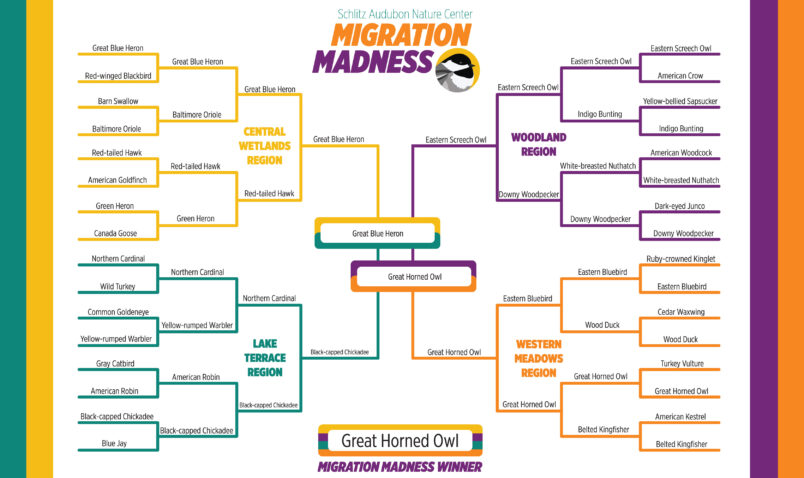Migration Madness
For many, March means basketball—but for bird lovers, it’s all about migration! As spring arrives, so do many bird species returning to Wisconsin. To celebrate, we hosted Migration Madness, a fun, bracket-style competition where anyone could participate by voting for their favorite birds!

We’ve come a long way from the original 32 species participating in this friendly competition. Winning 54% of the popular vote, our 2025 Migration Madness Champion is: the Great Horned Owl!
Check out this video featuring Raptor Educator Erin Toohey and Great Horned Owl Zari from Schlitz Audubon’s Raptor Program! Watch Zari proudly represent her species as Erin shares insights about this magnificent bird of prey:
Learn more about Great Horned Owls:
Great Horned Owls, nicknamed “tigers of the sky,” are apex predators, meaning that they are not prey for any other animal. Food availability and several adaptations allow Great Horned Owls to reside in Wisconsin all year long. They prefer dense forests but can be found in a variety of ecosystems.
FUN FACT
They have the strongest grip strength of all North American owl species and can take down prey as large as a raccoon or skunk.
SCHLITZ AUDUBON
Great Horned Owls are common residents at Schlitz Audubon, and can be sighted here year-round although they are more active around March and November. These apex predators are adaptable, and can be found anywhere around the Center, but show a clear preference for our South Ravine and Woodland Loop.
CONSERVATION STATUS & HOW TO SUPPORT
Great Horned Owls are currently of low conservation concern with a rating of 8 out of 20 on the Continental Concern Score. Though hunting them was abolished in the mid-twentieth century, some illegal hunting continues, and these owls are sometimes poisoned by toxins like pesticides that have accumulated in their prey. You can help Great Horned Owls by avoiding pesticide usage and putting out a nest structure for them ahead of the breeding season.
BREEDING & NESTING
Great Horned Owls have an early breeding and nesting season that begins in January, allowing them to secure desirable nest sites before other birds arrive. They re-use nests of Red-Tailed Hawks, crows, herons, or squirrels rather than building their own. Pairs, who often mate for life, perform hooting duets, with the female’s call being higher pitched than the male’s.